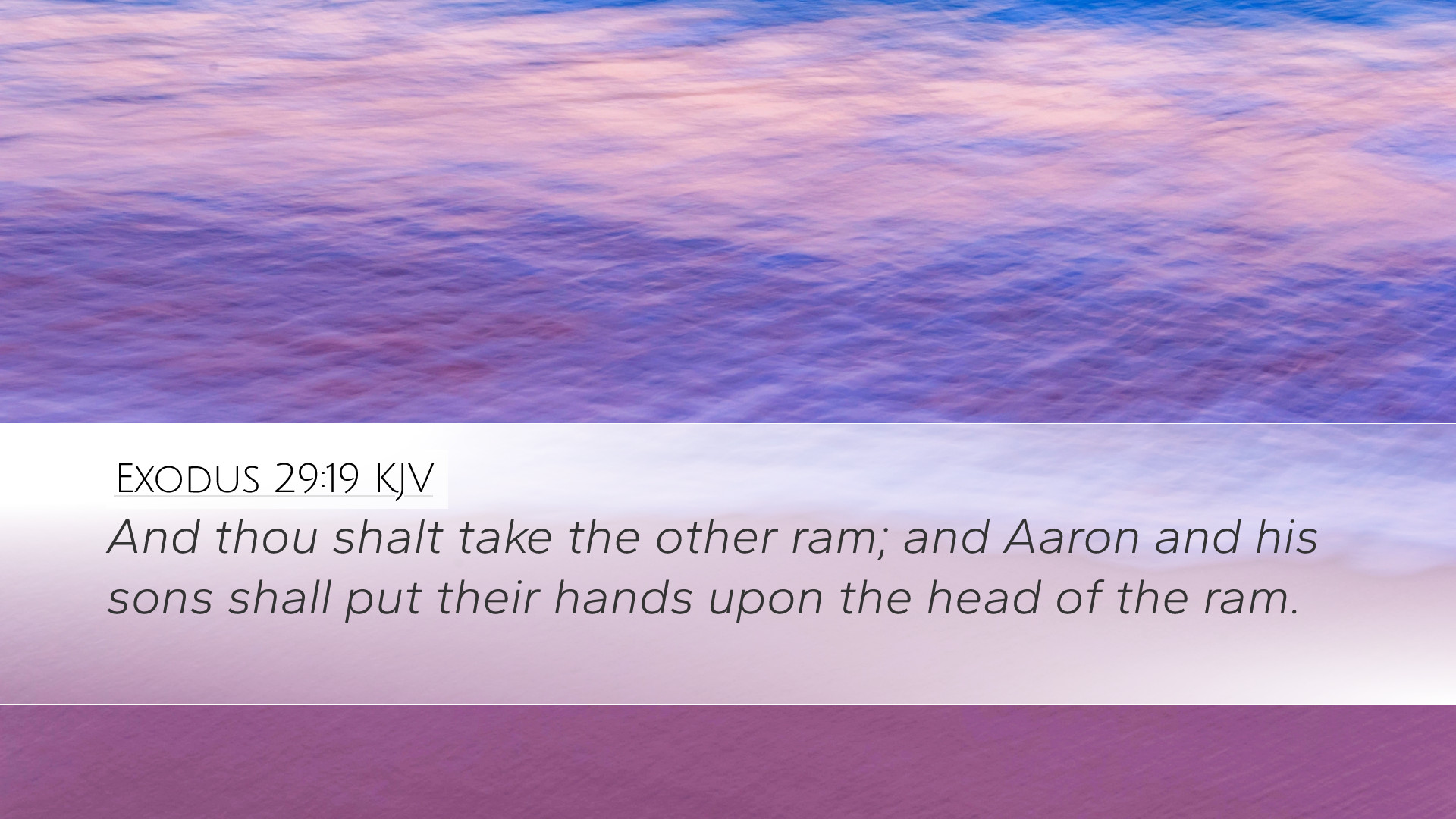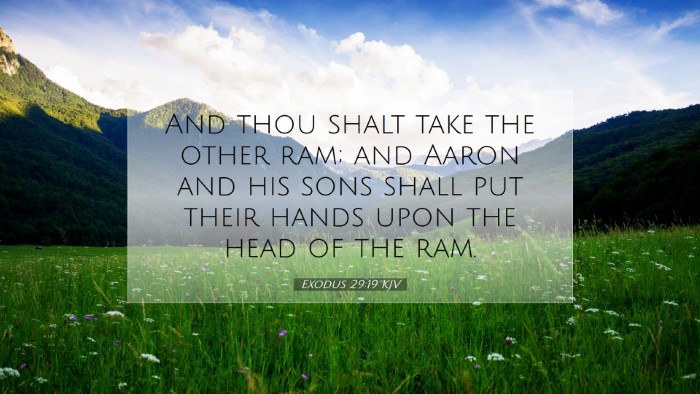Exodus 29:19 - Commentary Overview
Verse Text: "You shall take the other ram, and Aaron and his sons shall lay their hands on the head of the ram."
Introduction
The ritual described in Exodus 29 is foundational to the establishment of the priesthood in Israel. This specific verse is a critical part of the ceremony of consecration for Aaron and his sons. The act of laying hands on the ram signifies identification with the sacrificial animal, an act laden with theological implications, revealing both the gravity of sin and the importance of atonement.
The Significance of the Ram in the Consecration Ceremony
The ram serves a dual purpose in the context of the consecration of priests. In the commentary by Matthew Henry, the ram symbolizes a variety of spiritual truths. Henry describes that the ram is a significant offering due to its value and the role it plays in the atonement process. The ram's blood signifies the life that is given and the new beginnings for those consecrated. It is a reminder of God’s provision and mercy.
Albert Barnes elaborates further on the sacrificial nature of the ram when he notes that this process of laying hands on the ram underscores the transfer of guilt. The priests, by laying their hands, are identifying themselves with the offering, acknowledging that the sin and guilt that the ram represents are transferred to it. Thus, this physical act acts as a visual and tangible reminder of the need for atonement.
The Role of Laying on Hands
The action of laying hands on the ram carries significant weight within the biblical narrative. As noted by Adam Clarke, the act is deeply rooted in ancient Near Eastern practices where laying on hands was a common method of conferring authority or identification. In this case, Aaron and his sons are signifying their acceptance of their roles as priests and the burdens that come with it.
- Spiritual Identification: Clarke points out that this physical manifestation of identification reflects the deeper spiritual realities. It symbolizes the priest’s role as mediators between God and the people, taking on the sins of the community.
- Implication of Responsibility: The act also implicates the priests in a serious responsibility as leaders of worship and holiness before God.
Symbolism of the Ram's Sacrifice
The crux of the rite is the ram's sacrifice, which serves multiple theological implications. According to Matthew Henry, it is a foreshadowing of Christ's ultimate sacrifice. Just as the ram was set apart and consecrated for this rite, so too was Jesus set apart as the Lamb of God, who takes away the sins of the world.
Hebrews 10:1-4 contextualizes this by stating that the sacrifices were insufficient for permanent atonement, demonstrating that these Old Testament rituals pointed toward the greater sacrifice that Jesus would fulfill.
Integration into the Levitical Code
Exodus 29:19 sits within the broader context of Levitical law, which is essential for understanding the sacrificial system established for the Israelites. Albert Barnes discusses how this rite integrates into the Levitical framework, establishing a systemic approach to holiness that was to be embodied by the priests.
- Holiness Requirement: The priests were required to maintain a state of holiness, and this event marked a public declaration of their office and the expectations therein.
- Community Representation: The priests represented the community in their sacrifices, and this laying on of hands symbolizes the representation of Israel before God.
Theological Implications
From a theological perspective, Exodus 29:19 reveals profound insights into the nature of sacrifice and atonement. Adam Clarke asserts that the actions performed here allow for a glimpse into the character of God—a God who desires to be in a reconciled relationship with His people.
This sacrificial act conveys the seriousness of sin and the need for a mediator, reflecting the central message of the Gospel. Just as the ram was accepted as a satisfactory substitute, so Christ becomes the ultimate scapegoat for humanity’s sin.
Applications for Today
For pastors and theologians, the rituals surrounding the consecration of Aaron provide a framework for discussing the themes of sacrifice, holiness, and atonement within modern contexts. The importance of the laying on of hands continues to be relevant in contemporary practices of ordination and commissioning within the church.
- Pastoral Ministry: The significance of being set apart for service remains crucial in understanding pastoral roles today. Understanding this biblical foundation can strengthen the calling of modern ministers.
- Community Atonement: The collective aspect of confession and intercession for the community can foster a greater sense of unity and responsibility in congregational settings.
Conclusion
Exodus 29:19 is not merely a historical account but rather a rich tapestry of theological significance connecting the Old Testament sacrificial system to the New Testament revelation in Christ. The insights from Matthew Henry, Albert Barnes, and Adam Clarke are invaluable for gaining a deeper understanding of God's redemptive plan throughout Scripture. As such, this verse invites reflection on how we, as a community of believers, can embody the holiness and sacrificial love that God models through the priesthood of Aaron as well as in the life and ministry of Jesus Christ.


